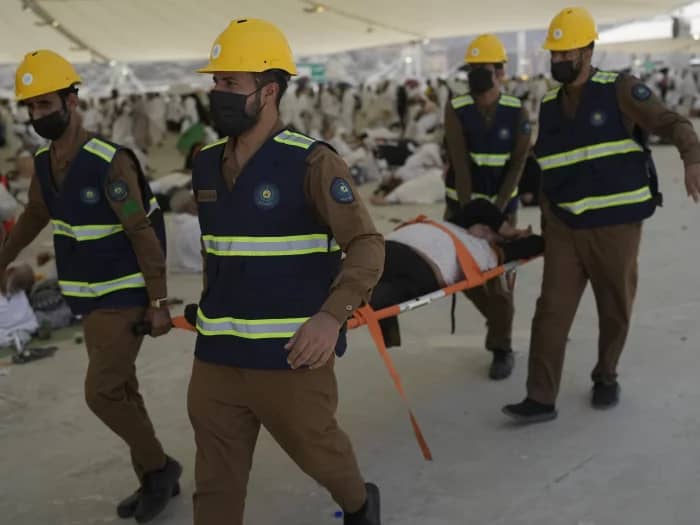
SUNSTROKE KILLS 14 PILGRIMS AS MUSLIMS BEGIN EID-AL-ADHA CELEBRATIONS
Under the intense summer heat, thousands of pilgrims in Saudi Arabia set out on a symbolic stoning of the devil on Sunday.
The ceremony ushers in the final days of the Hajj, or Islamic pilgrimage, and the commencement of the global Muslim holiday of Eid al-Adha.
One of the last rituals of the Hajj, one of the Five Pillars of Islam, is stoning. It happened the day after over 1.8 million pilgrims gathered at Mount Arafat, a holy hill outside the holy city of Mecca, where Muslims travel every year to complete the five-day Hajj ceremonies.
The Jordanian government-run Petra news agency reports that fourteen pilgrims have passed away from sunstroke while doing the Hajj.
The Foreign Ministry said in a statement that it has coordinated with Saudi authorities to bury the dead in Saudi Arabia, or transfer them to Jordan.
Mohammed Al-Abdulaali, spokesman for the Saudi Health Ministry, told reporters that more than 2,760 pilgrims suffered from sunstroke and heat stress on Sunday alone. He said the number was likely to increase and urged attendees to avoid the sun at peak times and drink water. “Heat stress is the greatest challenge,” he said.
The pilgrims left Mount Arafat on Saturday evening to spend their night in a nearby site known as Muzdalifa, where they collected pebbles to use in the symbolic stoning of pillars representing the devil.
The pillars are in another sacred place in Mecca, called Mina, where Muslims believe Ibrahim’s faith was tested when God commanded him to sacrifice his only son Ismail. Ibrahim was prepared to submit to the command, but then God stayed his hand, sparing his son. In the Christian and Jewish versions of the story, Abraham is ordered to kill his other son, Isaac.
On Sunday morning, crowds headed on foot to the stoning areas. Some were seen pushing disabled pilgrims on wheelchairs on a multi-lane road leading to the complex housing the large pillars. Most pilgrims were seen sweltering and carrying umbrellas to protect them against the burning summer sun.
An Associated Press reporter saw many pilgrims, especially among the elderly, collapsing on the road to the pillars because of the burning heat. Security forces and medics were deployed to help, carrying those who fainted on gurneys out of the heat to ambulances or field hospitals. As the temperature spiked by midday, more people required medical help. The heat had reached to 116.6 degrees in Mecca, and 114.8 degrees in Mina, according to Saudi meteorological authorities.
Despite the suffocating heat, many pilgrims expressed joy at being able to complete their pilgrimage.
“Thank God, (the process) was joyful and good,” said Abdel-Moaty Abu Ghoneima, an Egyptian pilgrim. “No one wants more than this.”
Many pilgrims will spend up to three days in Mina, each casting seven pebbles at three pillars in a ritual to symbolize the casting away of evil and sin.
While in Mina, they will visit Mecca to perform their “tawaf,” or circumambulation, which is circling the Kaaba in the Grand Mosque counterclockwise seven times. Then another circumambulation, the Farewell Tawaf, will mark the end of Hajj as pilgrims prepare to leave the holy city.
The rites coincide with the four-day Eid al-Adha, which means “Feast of Sacrifice,” when Muslims with financial means commemorate Ibrahim’s test of faith through slaughtering livestock and animals and distributing the meat to the poor.
Most countries marked Eid al-Adha on Sunday. Others, like Indonesia, will celebrate it Monday.
President Joe Biden in a statement wished Muslims around the world a blessed Eid al-Adha and noted the holiday is a time of prayer, reflection and sacrifice.
“The Hajj and Eid al-Adha remind us of our equality before God and the importance of community and charity — values that speak directly to the American character,” it said. “The United States is blessed to be home to millions of American Muslims who enrich our nation in countless ways, from medicine to technology, education, public service, the arts, and beyond.”
Once the Hajj is over, men are expected to shave their heads and remove the shroud-like white garments worn during the pilgrimage, and women to snip a lock of hair in a sign of renewal and rebirth.
Most of the pilgrims then leave Mecca for the city of Medina, about 210 miles away, to pray in Prophet Muhammad’s tomb, the Sacred Chamber. The tomb is part of the prophet’s mosque, one of the three holiest sites in Islam, along with the Grand Mosque in Mecca and the Al Aqsa Mosque in Jerusalem.
All Muslims are required to make the Hajj once in their lives if they are physically and financially able to do so. Many wealthy Muslims make the pilgrimage more than once. The rituals largely commemorate the accounts of Prophet Ibrahim and his son Prophet Ismail, Ismail’s mother Hajar and Prophet Muhammad, according to the Quran, Islam’s holy book.
More than 1.83 million Muslims performed Hajj in 2024, Saudi Hajj and Umrah Minister Tawfiq bin Fawzan al-Rabiah said in a briefing, slightly less than last year’s figures when 1.84 million made the rituals.
Most of the Hajj rituals are held outdoors with little if any shade. It is set for the second week of Dhu al-Hijjah, the last month in the Islamic lunar calendar, so its time of the year varies. And this year the pilgrimage fell in the burning summer of Saudi Arabia.
